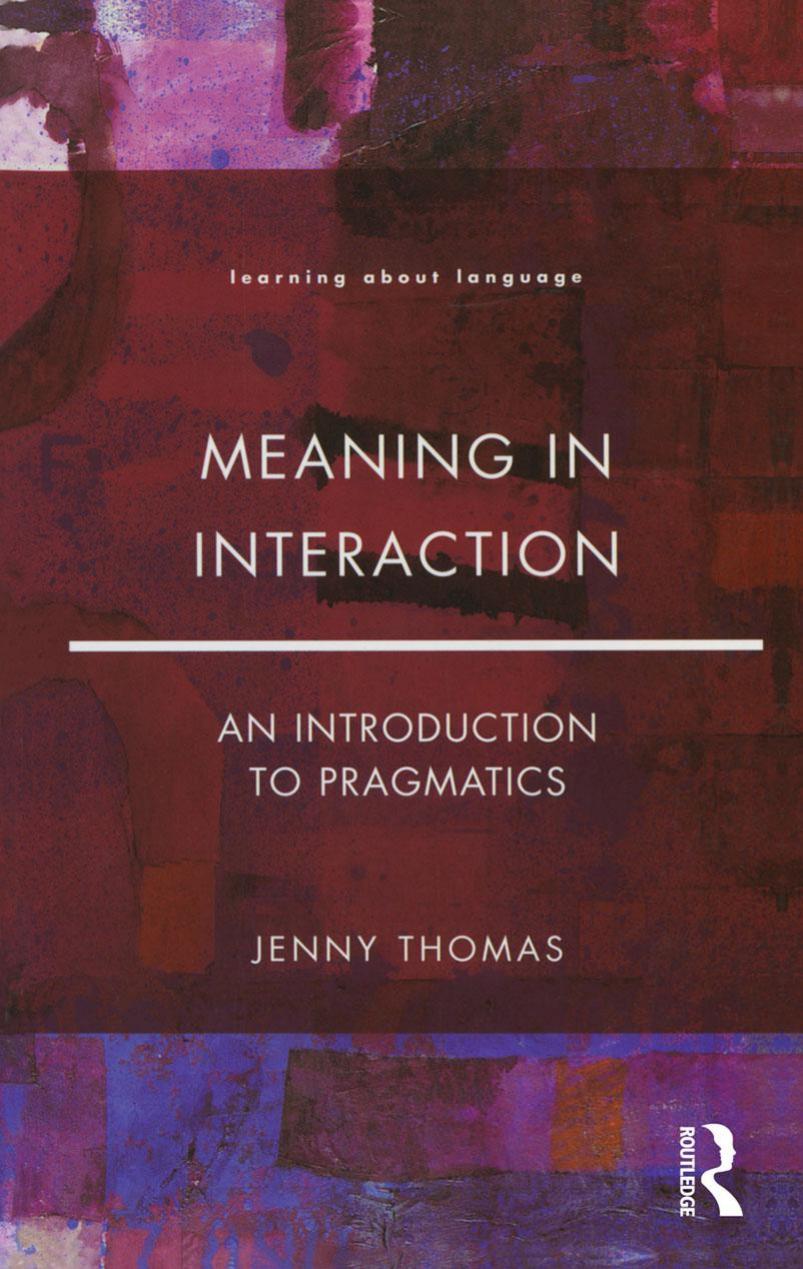Meaning in Interaction An Introduction to Pragmatics 1st Edition by Jenny Thomas ISBN 131788759X 9781317887591
$70.00 Original price was: $70.00.$35.00Current price is: $35.00.
Instant download Meaning in Interaction Thomas Jenny A after payment
Meaning in Interaction An Introduction to Pragmatics 1st Edition by Jenny A. Thomas – Ebook PDF Instant Download/Delivery: 131788759X, 9781317887591
Full dowload Meaning in Interaction An Introduction to Pragmatics 1st Edition after payment

Product details:
ISBN 10: 131788759X
ISBN 13: 9781317887591
Author: Jenny A. Thomas
Meaning in Interaction: An Introduction to Pragmatics is a comprehensive introductory text which discusses the development of pragmatics – its aims and methodology – and also introduces themes that are not generally covered in other texts. Jenny Thomas focuses on the dynamic nature of speaker meaning, considering the central roles of both speaker and hearer, and takes into account the social and psychological factors involved in the generation and interpretation of utterances. The book includes a detailed examination of the development of Pragmatics as a discipline, drawing attention to problems encountered in earlier work, and brings the reader up to date with recent discussion in the field. The book is written principally for students with no previous knowledge of pragmatics, and the basic concepts are covered in considerable detail. Theoretical and more complicated information is highlighted with examples that have been drawn from the media, fiction and real-life interaction, and makes the study more accessible to newcomers. It is an ideal introductory textbook for students of linguistics and for all who are interested in analysing problems in communication.
Meaning in Interaction An Introduction to Pragmatics 1st Table of contents:
1 What is pragmatics?
1.1 Introduction
1.2 Defining pragmatics
1.3 From abstract meaning to contextual meaning
1.3.1 Assigning sense in context
1.3.2 Assigning reference in context
1.3.3 Structural ambiguity
1.3.4 Interaction of sense, reference and structure
1.3.5 Ambiguity and intentionality
1.4 Utterance meaning: the first level of speaker meaning
1.4.1 Importance of utterance meaning
1.5 Force: the second level of speaker meaning
1.5.1 Understanding both utterance meaning and force
1.5.2 Understanding utterance meaning but not force
1.5.3 Understanding force but not utterance meaning
1.5.4 Understanding neither utterance meaning nor force
1.5.5 Interrelationship of utterance meaning and force
1.6 Definitions of pragmatics (revisited)
1.6.1 Speaker meaning
1.6.2 Utterance interpretation
1.6.3 Pragmatics: meaning in interaction
1.7 Summary
2 Speech acts
2.1 J. L. Austin
2.2 Ordinary language philosophy
2.3 Logical positivism and truth conditional semantics
2.4 The performative hypothesis
2.4.1 Metalinguistic performatives
2.4.2 Ritual performatives
2.4.2.1 Felicity conditions
2.4.2.2 Explicit reference to felicity conditions
2.4.3 Collaborative performatives
2.4.4 Group performatives
2.4.5 Overlap of categories
2.4.6 Cross-cultural differences in the use of performatives
2.4.7 Collapse of Austin’s performative hypothesis
2.4.7.1 The grammatical distinctiveness of performatives
2.4.7.2 Do performatives always perform actions?
2.4.7.3 How to do things without performative verbs
2.4.8 Explicit and implicit performatives
2.5 Utterances as actions
2.5.1 Locution, illocution, perlocution
2.5.2 Speech acts
2.6 Conclusion
3 Conversational implicature
3.1 Introduction
3.2 H. P. Grice
3.3 Implicature
3.3.1 Conventional implicature
3.3.2 Conversational implicature
3.3.3 Implicature and inference
3.4 The Cooperative Principle
3.5 The four conversational maxims
3.5.1 Observing the maxims
3.5.2 Non-observance of the maxims
3.6 Flouting a maxim
3.6.1 Flouts necessitated by a clash between maxims
3.6.2 Flouts which exploit a maxim
3.6.2.1 Flouts exploiting maxim of Quality
3.6.2.2 Flouts exploiting the maxim of Quantity
3.6.2.3 Flouts exploiting the maxim of Relation
3.6.2.4 Flouts exploiting the maxim of Manner
3.7 Other categories of non-observance of the conversational maxims
3.7.1 Violating a maxim
3.7.2 Infringing a maxim
3.7.3 Opting out of a maxim
3.7.4 Suspending a maxim
3.8 Testing for implicature
3.8.1 Non-detachability and non-conventionality
3.8.2 Implicature changes
3.8.3 Calculability
3.8.4 Defeasibility
3.9 Conclusion
4 Approaches to pragmatics
4.1 Introduction
4.2 Problems with Grice’s theory
4.2.1 When is non-observance intentional?
4.2.2 Distinguishing between types of non-observance
4.2.3 Different nature of maxims
4.2.4 Maxims may overlap
4.2.5 Problems of calculability
4.3 Grice’s informal approach
4.4 J. R. Searle
4.4.1 Indirect speech acts
4.4.2 Searle’s conditions for speech acts
4.4.2.1 Distinguishing speech acts
4.4.2.2 Plugging the gaps in Searle’s rules
4.4.2.3 The speech act of apologizing: a case study
4.4.2.4 Over-generality of rules
4.4.2.5 The speech act of warning: a case study
4.5 Searle’s formal approach to the categorization of speech acts
4.6 Rules versus principles
4.6.1 Rules are all or nothing, principles are more or less
4.6.2 Rules are exclusive, principles can co-occur
4.6.3 Rules are constitutive, principles are regulative
4.6.4 Rules are definite, principles are probabilistic
4.6.5 Rules are conventional, principles are motivated
4.7 Conclusion
5 Pragmatics and indirectness
5.1 Introduction
5.2 Pragmatics and indirectness
5.2.1 Intentional indirectness
5.2.2 Indirectness is costly and risky
5.2.3 Assumption of rationality
5.2.4 The principle of expressibility
5.2.5 Indirectness — an illustration
5.3 How do we know how indirect to be?
5.3.1 Power
5.3.2 Social distance
5.3.3 Size of imposition
5.3.4 Rights and obligations
5.3.5 The negotiation of pragmatic parameters
5.4 Measuring indirectness
5.4.1 The role of context in interpreting indirectness
5.4.2 The role of belief in interpreting indirectness
5.4.3 Background knowledge and interpreting indirectness
5.4.4 The role of co-text in interpreting indirectness
5.4.5 Goals and the interpretation of indirectness
5.5 Why use indirectness?
5.5.1 Interestingness
5.5.2 Increasing the force of one’s message
5.5.3 Competing goals
5.6 Conclusion
6 Theories of politeness
6.1 Introduction
6.2 Delimiting the concept of politeness
6.2.1 Politeness as a real-world goal
6.2.2 Deference versus politeness
6.2.3 Register
6.2.4 Politeness as an utterance level phenomenon
6.2.5 Politeness as a pragmatic phenomenon
6.3 Politeness explained in terms of principles and maxims
6.3.1 Ambivalence and politeness
6.3.2 Pragmatic principles
6.3.2.1 The Tact maxim
6.3.2.2 The Generosity maxim
6.3.2.3 The Approbation maxim
6.3.2.4 The Modesty maxim
6.3.2.5 The Agreement maxim
6.3.2.6 The Pollyanna Principle
6.3.3 Problems with the Leech’s approach
6.4 Politeness and the management of face
6.4.1 Face-threatening acts
6.4.1.1 Superstrategies for performing face-threatening acts
6.4.1.2 Performing an FTA without any redress (bald-on-record)
6.4.1.3 Performing an FTA with redress (positive politeness)
6.4.1.4 Performing an FTA with redress (negative politeness)
6.4.1.5 Performing an FTA using off-record politeness
6.4.1.6 Do not perform FTA
6.4.2 Criticisms of Brown and Levinson
6.5 Politeness viewed as a conversational contract
6.6 Politeness measured along pragmatic scales
6.7 Conclusion
7 The construction of meaning
7.1 Introduction
7.2 How does pragmatics fit into linguistics?
7.3 Pragmatics versus sociolinguistics
7.3.1 Overlap between pragmatics and sociolinguistics
7.4 Activity types versus speech events
7.5 The construction of meaning
7.5.1 Pragmatic ambivalence
7.5.2 The collaborative nature of speech acts
7.5.3 The negotiability of force
7.5.4 Preparing the ground for a speech act
7.5.5 Successive utterances in situated discourse
7.5.6 Discoursal ambivalence
7.5.7 Dynamic pragmatics
7.6 What counts as evidence in pragmatics?
7.6.1 Perlocutionary effect
7.6.2 Explicit commentary by speaker
7.6.3 Explicit commentary by others
7.6.4 Co-text (subsequent discourse)
7.7 Conclusion
People also search for Meaning in Interaction An Introduction to Pragmatics 1st:
meaning in interaction an introduction to pragmatics
thomas j. (1995). meaning in interaction an introduction to pragmatics
meaning in interaction an introduction to pragmatics pdf
introduction to semantics in linguistics
introduction to pragmatics syllabus


